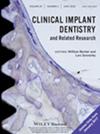Biocompatibility and dimensional stability through the use of 3D-printed scaffolds made by polycaprolactone and bioglass-7: An in vitro and in vivo study
Abstract
Purpose
This experiment aimed to observe the differences in biological properties by producing BGS-7 + PCL scaffolds with different weight fractions of BGS-7 through 3D printing and to confirm whether using the scaffold for vertical bone augmentation is effective.
Materials and Methods
Cube-shaped bioglass (BGS-7) and polycaprolactone (PCL) scaffolds with different weight fractions (PCL alone, PCL with 15% and 30% BGS-7) are produced using 3D printing. The surface hydroxyapatite (HA) apposition, the pH change, proliferation and attachment assays, and various gene expression levels are assessed. After a 7-mm implant was inserted 3 mm into the rabbit calvaria, vertical bone augmentation is performed around the implant and inside the scaffold in four ways: scaffold only, scaffold+bone graft, bone graft only, and no graft. Sacrifice is performed at 6, 12, and 24 weeks, and the various parameters are compared radiographically and histologically.
Results
HA apposition, cell proliferation, cell attachment, and expression of osteogenic genes increase as the proportion of BGS-7 increase. In the in vivo test, a higher bone–implant contact ratio, bone volume ratio, bone mineral density, and new bone area are observed when the scaffold and bone grafts were used together.
Conclusion
The 3D-printed scaffold, a mixture of BGS-7 and PCL, exhibit higher biological compatibility as the proportion of BGS-7 increase. Additionally, the use of scaffold is effective for vertical bone augmentation.

 求助内容:
求助内容: 应助结果提醒方式:
应助结果提醒方式:


